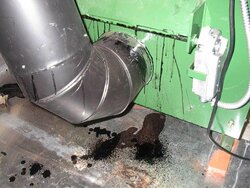td182a
New Member
Anthony D, you have a very proffesional setup! Looks good.
I am thinking I should get a draft meter rather than just guesstimating. What is the brand of the one you have in your photo? Works well?
As for stack temp, is that one of the magnetic ones in the photo? Works well?
I suspect the temp at the chimney top is not very high, I can hold my hand in it easily. The Greenwood is only supposed to be 350 or so coming out of the stove. By the time it travels through 21 ft of Masonary chimney, its cooled off substancially.
As for a buffer tank, I have the Greenwood circulating the existing oil fired boiler, using its water volume for a buffer. I have the supplied high temp switch hooked to a relay controlling the house heat, if the water outlet on the stove reaches 200 degrees, the house heating system kicks in. I also have a 90,000 BTU exchanger hooked in for DHW, the electric heater is shut off. We have 4 kids, so hot water is in constant use!
I have 56 inches of 8 in black pipe not including 2 90's, going too 21 feet of 7X11 clay lined masonary chimney inside the house and integeral with another flue from a Pacific Fireplace insert upstairs burning the same wood very well and cleanly. I just installed a draft inducer which has reduced the smoke problem, and I think it has somewhat reduced the creosote problem.
I will try to attach a photo showing the creosote from the draft door and leaking from the chimney.
I am thinking I should get a draft meter rather than just guesstimating. What is the brand of the one you have in your photo? Works well?
As for stack temp, is that one of the magnetic ones in the photo? Works well?
I suspect the temp at the chimney top is not very high, I can hold my hand in it easily. The Greenwood is only supposed to be 350 or so coming out of the stove. By the time it travels through 21 ft of Masonary chimney, its cooled off substancially.
As for a buffer tank, I have the Greenwood circulating the existing oil fired boiler, using its water volume for a buffer. I have the supplied high temp switch hooked to a relay controlling the house heat, if the water outlet on the stove reaches 200 degrees, the house heating system kicks in. I also have a 90,000 BTU exchanger hooked in for DHW, the electric heater is shut off. We have 4 kids, so hot water is in constant use!
I have 56 inches of 8 in black pipe not including 2 90's, going too 21 feet of 7X11 clay lined masonary chimney inside the house and integeral with another flue from a Pacific Fireplace insert upstairs burning the same wood very well and cleanly. I just installed a draft inducer which has reduced the smoke problem, and I think it has somewhat reduced the creosote problem.
I will try to attach a photo showing the creosote from the draft door and leaking from the chimney.



 ) and other 'junk' wood that needed cleaning up. This year, a combination of better wood (read, lower moisture content red oak) and more experience (read, leave the damn load door closed for 8 hours at a time! and don't over fill the box) and the aforementioned 'gunk' is way less this year.
) and other 'junk' wood that needed cleaning up. This year, a combination of better wood (read, lower moisture content red oak) and more experience (read, leave the damn load door closed for 8 hours at a time! and don't over fill the box) and the aforementioned 'gunk' is way less this year.